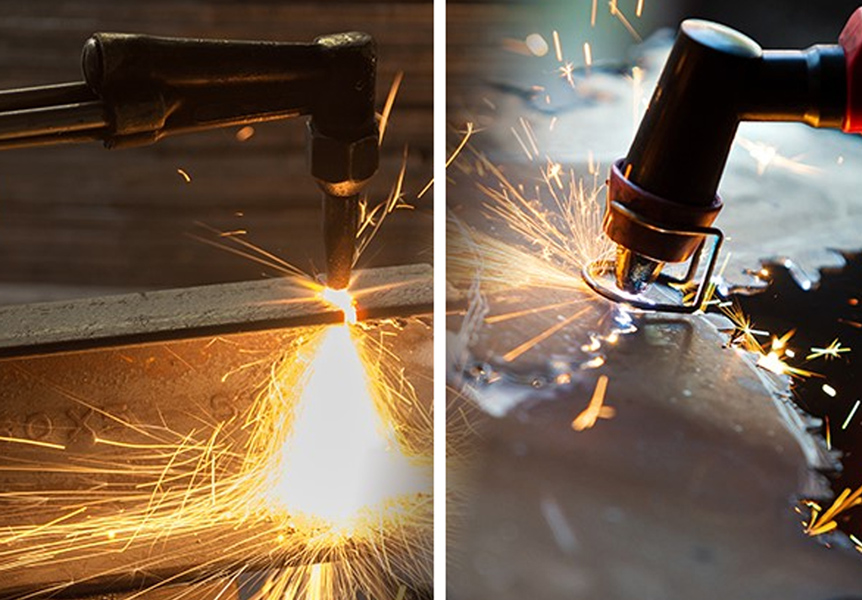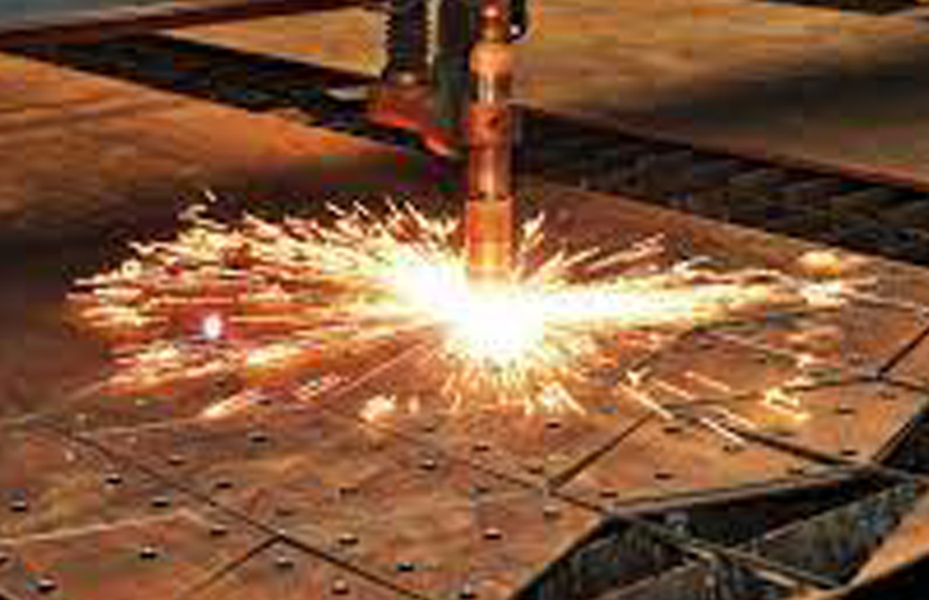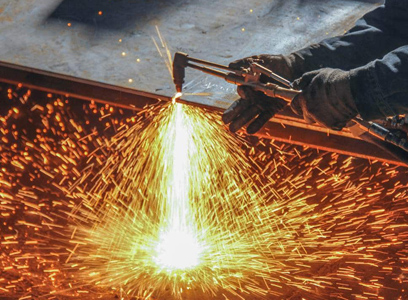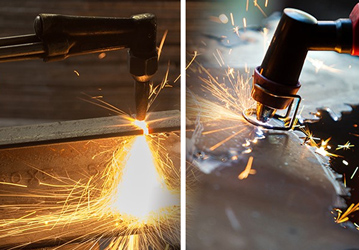Metal cutting is a critical process in various industries, demanding precision and efficiency. In this article, we’ll delve into a comprehensive comparison of plasma cutting and oxy-fuel cutting, exploring their distinct advantages, limitations, and ideal applications. Understanding the nuances of these cutting techniques is crucial for businesses seeking the most suitable method for their specific cutting needs.

Understanding Plasma Cutting and Oxy-Fuel Cutting
Plasma cutting is a thermal cutting process that utilizes a high-velocity jet of ionized gas to melt and expel material from the workpiece. This method is highly versatile and is particularly effective for cutting conductive materials such as steel, stainless steel, aluminum, copper, and other non-ferrous metals. The precision and speed of plasma cutting make it a popular choice for various applications, including industrial fabrication, automotive repair, and artistic metalwork.
On the other hand, oxy-fuel cutting involves the use of a fuel gas, typically acetylene, in combination with pure oxygen to create a high-temperature flame. This flame is directed at the workpiece, causing the material to undergo a chemical reaction with the oxygen, resulting in the formation of iron oxide or slag. Oxy-fuel cutting is well-suited for thick carbon steel and is often preferred for its cost-effectiveness, especially in heavy-duty applications such as shipbuilding, construction, and infrastructure development.
Pros and Cons of Plasma Cutting
Plasma cutting offers several advantages, including high precision, minimal heat-affected zone, and the ability to cut a wide range of materials and thicknesses. Its ability to produce intricate shapes and patterns makes it an ideal choice for artistic metalwork and detailed fabrication projects. Plasma cutting produces minimal dross, resulting in cleaner cuts and reduced post-cutting cleanup. However, the initial equipment and operating costs for plasma cutting systems can be higher compared to oxy-fuel cutting, which may be a consideration for some businesses.
While plasma cutting excels in precision and versatility, it may not be as cost-effective as oxy-fuel cutting for thicker materials. Plasma cutting systems may require more frequent maintenance and consumable replacement, adding to the overall operational expenses. Proper training and understanding of the equipment’s capabilities are crucial for achieving optimal results with plasma cutting.

Pros and Cons of Oxy-Fuel Cutting
Oxy-fuel cutting is renowned for its cost-effectiveness, particularly in handling thick carbon steel. The simplicity of the equipment and the relatively lower operating costs make oxy-fuel cutting an attractive option for heavy-duty applications. Oxy-fuel cutting systems are often more portable and can be used in outdoor settings, providing flexibility for on-site cutting requirements. The process is relatively straightforward, making it accessible to operators with varying levels of experience.
However, oxy-fuel cutting has limitations when it comes to precision and the ability to cut non-ferrous metals. The heat-affected zone in oxy-fuel cutting is larger compared to plasma cutting, which can result in greater material distortion and warping. While oxy-fuel cutting is effective for thick materials, it may not be suitable for intricate designs or detailed cutting requirements. Businesses considering oxy-fuel cutting should assess their specific project needs and the limitations of this method.

Cost Comparison Between Plasma and Oxy-Fuel Cutting
When evaluating the cost implications of plasma cutting versus oxy-fuel cutting, it’s essential to consider the initial equipment investment, operational expenses, and long-term maintenance requirements. While plasma cutting systems generally have higher upfront costs, they offer advantages in precision, material versatility, and reduced post-cutting cleanup. Oxy-fuel cutting, on the other hand, may have lower initial equipment costs but can incur higher consumable expenses and limited material cutting capabilities.
Businesses should conduct a comprehensive cost analysis that accounts for the specific cutting requirements, material types, and thicknesses involved in their projects. Additionally, factors such as energy efficiency, consumable consumption, and overall production efficiency should be considered when determining the most cost-effective cutting method for a particular application.
Precision and Speed: Plasma vs Oxy-Fuel Cutting
Precision and speed are critical considerations in metal cutting processes, as they directly impact the quality of the end product and the overall efficiency of production. Plasma cutting excels in precision, offering the ability to achieve intricate cuts and detailed designs with minimal material distortion. The high cutting speeds of plasma systems contribute to efficient production rates, making it suitable for a wide range of applications where accuracy and productivity are paramount.
Conversely, while oxy-fuel cutting is effective for thick materials, its precision capabilities are limited, particularly when it comes to intricate designs and fine detailing. The slower cutting speeds of oxy-fuel systems may impact overall production timelines, especially for projects that require precision and rapid turnaround. Businesses should assess the balance between precision and speed based on their specific cutting requirements and project timelines.
Materials Suitable for Plasma and Oxy-Fuel Cutting
Plasma cutting is well-suited for a diverse range of materials, including steel, stainless steel, aluminum, copper, and other non-ferrous metals. Its ability to cut thinner materials with high precision makes it an ideal choice for applications such as metal artistry, thin sheet metal fabrication, and intricate parts production. The versatility of plasma cutting extends to various industries, including aerospace, automotive, and general manufacturing, where the demand for intricate and precise cutting is prevalent.
On the other hand, oxy-fuel cutting is primarily used for thick carbon steel due to its ability to deliver cost-effective cuts in these materials. While oxy-fuel cutting may have limitations in cutting non-ferrous metals and thinner materials, it remains a preferred method for heavy-duty applications that prioritize cost efficiency and material thickness. Businesses should assess the material requirements of their projects to determine the most suitable cutting method based on material type and thickness.
Environmental Impact of Plasma and Oxy-Fuel Cutting
Environmental considerations play a significant role in modern manufacturing processes, prompting businesses to assess the environmental impact of their operations, including metal cutting methods. Plasma cutting, with its focus on precision and reduced material waste, offers environmental advantages in terms of material conservation and minimized post-cutting cleanup. Advancements in plasma cutting technology have led to the development of systems with enhanced energy efficiency and reduced emissions.
Oxy-fuel cutting, while effective for certain applications, may have environmental implications due to the combustion process and the generation of by-products such as slag and fumes. Businesses utilizing oxy-fuel cutting should implement proper ventilation and emission control measures to mitigate the impact of these by-products on the surrounding environment. When evaluating cutting methods, businesses should consider the environmental implications and explore opportunities to minimize their environmental footprint through sustainable cutting practices.
Safety Considerations for Plasma and Oxy-Fuel Cutting
The safety of operators and personnel involved in metal cutting processes is paramount, highlighting the importance of understanding the safety considerations associated with plasma cutting and oxy-fuel cutting. Plasma cutting systems utilize high-velocity ionized gas and require operators to adhere to strict safety protocols, including the use of personal protective equipment (PPE) and proper ventilation in the workspace. Training and awareness of potential hazards are crucial for maintaining a safe working environment with plasma cutting.
Similarly, oxy-fuel cutting necessitates adherence to safety guidelines to mitigate the risks associated with high-temperature flames and potential gas leaks. Proper handling and storage of fuel gases and oxygen cylinders are essential to prevent accidents and ensure the safety of personnel. Businesses should prioritize comprehensive safety training for operators and establish clear protocols for handling cutting equipment and related hazards.
Choosing the Right Cutting Method for Your Project
Selecting the ideal cutting method for a project requires a thorough assessment of the specific cutting requirements, material types, thicknesses, precision needs, and budget considerations. Businesses should conduct a comprehensive analysis of their cutting needs, considering factors such as material versatility, precision capabilities, production efficiency, environmental impact, and long-term cost implications.
Consulting with experienced professionals and equipment suppliers can provide valuable insights into the most suitable cutting method for a particular application.
By understanding the nuances of plasma cutting and oxy-fuel cutting, businesses can make informed decisions that align with their project goals and operational requirements. Whether it’s achieving intricate designs in metal artistry or optimizing production efficiency in industrial fabrication, the choice of cutting method plays a pivotal role in the overall success of metal cutting projects.
Selecting the Ideal Cutting Method
The comparison between plasma cutting vs oxy-fuel cutting underscores the importance of evaluating cutting methods based on the specific needs and parameters of each project. While plasma cutting excels in precision, versatility, and material suitability for thinner metals, oxy-fuel cutting offers cost-effective solutions for thick carbon steel and heavy-duty applications. Businesses should prioritize a comprehensive assessment of their cutting requirements, including material types, thicknesses, precision needs, and long-term cost considerations, to select the ideal cutting method that aligns with their project objectives.
With a nuanced understanding of the strengths, limitations, and applications of plasma cutting and oxy-fuel cutting, businesses can leverage the right cutting method to optimize their metal cutting processes and achieve exceptional results in various industrial and artistic endeavors. The choice between plasma cutting and oxy-fuel cutting ultimately hinges on a holistic evaluation of project-specific factors, empowering businesses to make informed decisions that drive efficiency, precision, and success in metal cutting endeavors.
Conclusion
The comparative analysis of plasma cutting and oxy-fuel cutting provides valuable insights for businesses seeking to optimize their metal cutting processes and select the most suitable cutting method for their specific applications. By understanding the distinctive benefits and limitations of plasma cutting and oxy-fuel cutting, businesses can make informed decisions that align with their project goals, production efficiency, and long-term cost considerations. Whether it’s achieving intricate designs in metal artistry or meeting the demands of heavy-duty industrial applications, the right cutting method plays a pivotal role in driving success and excellence in metal cutting endeavors.
